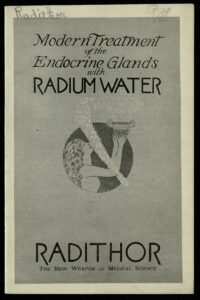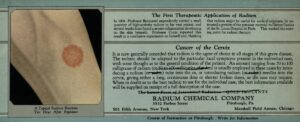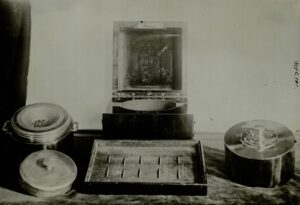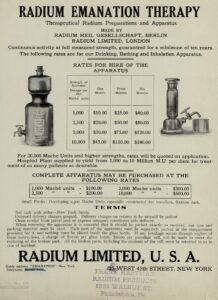– by Patrick Magee, Visitor Services/Gallery Associate
As covered in previous Mütter Medicine Mondays posts, the cutting edge of medical treatment is rarely a place free from debate. A common theme found in emergent medicine is the trade-off: what inconveniences will be had, or sacrifices will be made, to improve one’s prognosis overall? Radiation and radium therapy remain at the forefront of these discussions due to their roles as diagnostic tools and treatments for maladies like cancer, but their medical uses present similar dilemmas to those seen throughout the world when other forms of nuclear energy are invoked.

One of the earliest studies of the effects of radiation occurred in the late 1800s, quite literally at the hands of Emil Grubbe. In his experiments, he applied increasing amounts of radiation to his hand via x-ray, until eventually his hand suffered quite a bit of damage. Although his results were alarming, continued examination and thought from his doctors lead to the hypothesis that the technology could be used in effective and controlled ways. Grubbe and his doctors concluded that if there was tissue that needed to be eliminated, surely radiation therapy would be an effective means of doing so (Markel).

The following years saw leaps and bounds in the quality of and use cases for radiation therapy. By 1921, Mütter Museum favorite Marie Curie was essentially the face of the technology – but her work was defined by a struggle of supply, resulting in a trip to America meant to raise funds and supplies to further research. On May 20th of that year, Curie met with President Warren G. Harding to be formally presented with a radium sample and research rights, paving the way for future developments (Suplee).

According to research from the National Institute of Health, “The successive period, from 1930 to 1950, was characterized by continuous scientifical progress to treat patients affected by deep cancers (“An Overview on Radiotherapy: From Its History to Its Current Applications in Dermatology”).” As you’re no doubt aware, this period also saw the use of nuclear weapons at the end of World War II, which resulted in a mix of physical destruction and sociopolitical discourse with reverberations still felt to this day. The technology proved to be perhaps brutally dualistic in nature on both micro and macro levels.

In more recent history, radiation technology has progressed to a point where its medical and energy-based applications are refined, controlled, and most of all – regular. Radiation therapy is an essential facet of cancer treatment to this day, and years of improvement have resulted in a myriad of pain management options for its side effects. Much of the literature and medical guidance surrounding cancer treatment focuses on coping and the (re) development of comfort. The technology, like any other, could see and use improvements still – but there is no argument that results and use cases have both improved in nature since the 1950s (“Radiation Therapy – Mayo Clinic.”).

In the twilight of the 100th anniversary of Marie Curie’s presentation of the piezo-electric generator, the collective knowledge and application of radiation technology has developed beyond what 1920s scientists could have foreseen. In modern applications, even the sites of major nuclear disasters such as Fukushima, Japan are using emergent technology to repurpose, clean and redistribute nuclear power. Such a development has resulted in quite a bit of debate, and it goes without saying that nuclear technology’s use – whether by individual or institution – is never considered lightly. The key to its longevity, much like any other practice that could be dangerous in the wrong hands or means, has been reliable repetition of results.
Works Cited
“An Overview on Radiotherapy: From Its History to Its Current Applications in Dermatology.” PubMed Central (PMC), 25 July 2017, www.ncbi.nlm.nih.gov/pmc/articles/PMC5535674.
Curtis.suplee@nist.gov. “1921: Marie Curie Visits the U.S.” NIST, 26 Sept. 2016, www.nist.gov/pml/marie-curie-and-nbs-radium-standards/1921-marie-curie-visits-us.
Markel, Dr. Howard. “How Playing with Dangerous x-Rays Led to the Discovery of Radiation Treatment for Cancer.” PBS, Public Broadcasting Service, 28 Jan. 2015, www.pbs.org/newshour/health/emil-grubbe-first-use-radiation-treat-breast-cancer.
“Radiation Therapy – Mayo Clinic.” Mayo Clinic, 1 July 2020, www.mayoclinic.org/tests-procedures/radiation-therapy/about/pac-20385162.
